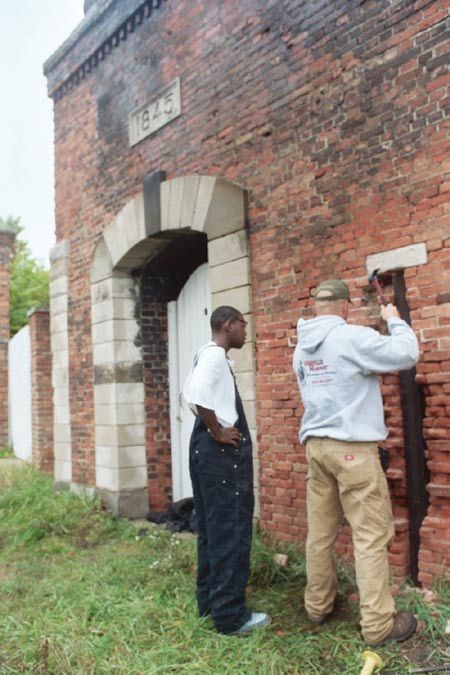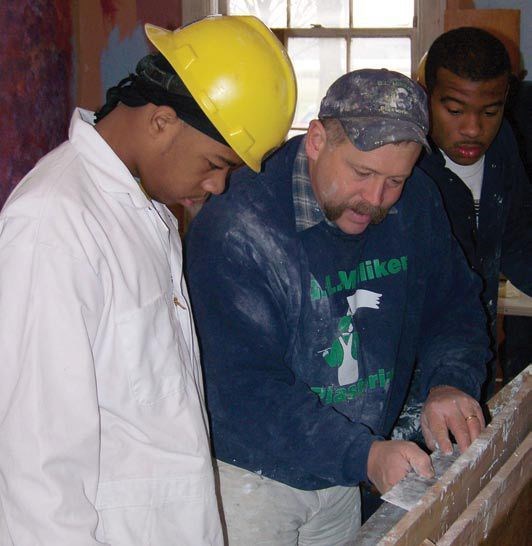Last updated: April 7, 2025
Article
Podcast 006: Preservation Trades with Nancy Finegood

Randolph’s Career and Technical Center
Andy Ferrell: So good morning Nancy. Welcome to the podcast.
Nancy Finegood: Good morning. I am very excited to be joining you.
Andy Ferrell: NCPTT recently published online a guide titled “Introducing Preservation Trades to High School Students” which grew out of via work with Detroit’s Randolph’s Career and Technical Center. Can you tell us a little bit about this publication?
Nancy Finegood: Sure the publication actually evolved from successful grass roots program that the Michigan Historic Preservation Network began about four years ago at Detroit’s Randolph’s Career and Technical Center.
Andy Ferrell: And what was the genesis of that project?
Nancy Finegood: We were contacted by a teacher from Randolph’s school who was very interested in working with his students in rehabbing homes instead of just building new like they do for habitat and got us involve got the state historic preservation office involved and others in the Detroit community. We started the program about four years ago. The program at Randolph was so successful that we wanted to share the program with other preservation educators around the United States.
Andy Ferrell: How did this collaborate effort with NCPTT begin?
Nancy Finegood: NCPTT assisted us with funding to convene a sort of summit of experts from a wide range of preservation organizations and educational institutions. The goal of the summit was to bring together preservation educators everything from grassroots high school features to college professors from around the country to share their ideas and document their experiences and help us create this publication. One of our board members Tim Turner is a wood window restoration specialist and he was one of the instructors for the Randolph School program. He traveled to Louisiana to meet with Kirk Cordell the director of your organization and Jim felt that this program that we started in Detroit could be a model for others around the United States.
He was aware that the NCPTT had been instrumental in promoting the program at the Brooklyn High School of the Arts and he approached them to collaborate with us to create a guide so that could be utilized in programs around the entire United States. The ultimate goal of I think both programs is to train students who see appropriate preservation of historic resources as another career opportunity.

Randolph’s Career and Technical Center
Nancy Finegood: I think the major thing that we have to keep in mind is that every program needs a passionate champion to carry the piton at Randolph’s school. It was Rody Rivers the teacher that I mentioned earlier who wanted to introduce his students to preservation and tradition building schools in Brooklyn. It was Kate Burns out of Vino the director of preservation technology at the New Jersey Institute of Technology. We found that if you do not have someone in the community truly passionate to start the program and to see it through because it does take quite a bit of effort the program will not be successful. So we have been trying to reach out to different sort of champions in communities to start new programs.
Andy Ferrell: Fascinating, tell me a little bit about the students. Who were the students?
Nancy Finegood: The students were awesome. Make sure you take a look at the video that’s on the NCPTT website. You’ll see the students up close and hear some of their interviews. What was interesting was that all the students were self selected. So we didn’t say you need to learn about preservation because you are in carpentry or you need to add preservation to your cab design program.
We took the students on a tour of historic sites of Detroit in the situation in this cause and then we did a half day program an educational program about general preservation and what it means. They self selected themselves and not only did they work at a historic site. They missed some of their other class time, and they needed to commit to fulfilling their other classroom requirements. That’s a lot of work for a high school student.
The first year of our program there were ten boys and one girl. She had a hard time, but she followed through and committed to fulfilling all the requirements in her classroom and at the site that we had chosen in the community. Another requirement in order to participate was that the student’s parents or guardian had to come to an organizational meeting and agree to their participation and all 11 parents showed up and agreed which is unheard of in most school districts much less a school district like Detroit. So that was really exciting.
Andy Ferrell: That is exciting. Now how did the students enjoy working on historic buildings?
Nancy Finegood: They loved working on the Historic building. We chose Historic Fort Wayne as our laboratory. Historic Fort Wayne is owned by the city of Detroit Parks and Recreation department. It is a city that is very important to the city but had become downtrodden and was sorely in need of some help. So we chose one building on the site as their working lab which they traveled to four days a week the first year of the program.
One student told me that he heard of the fort but had never been there even though it was walking distance from his home. Another student said this was one of my favorites now that he has taken this course he can fix his grandma’s old windows instead of calling Wallsite.

Randolph’s Career and Technical Center
Andy Ferrell: That is great that is great. The instructors were they all staff at Randolph?
Nancy Finegood: No they weren’t actually. The first year all the instructors were recruited from preservation professionals around the state. Some traveled o I would say over 100 miles round trip just to participate in the program. They were paid a small stipend the first year but really taught primarily because they felt strongly about training these students.
They would come to organizational meetings I mean their buy in was spectacular one of the instructors young preservation carpenter said I wish there was a program like this when I was in high school. It took me many years after high school to find this kind of training. The following years we had a grant from the State Historic Preservation Office to do the program. In the following years our funding diminished.
We had a little bit of help from some local foundations and others but many of this instructors wanted to see this program continue and they volunteered their time as did Randolph school teachers. We actually had kids that wanted to come out there because they had heard how wonderful the program was and of course the food was good too. So the electrical heating and cooling teacher brought his students out there to repair the furnace because there was no heat in the building so that was volunteer and additional.
There was no working plumbing which was an issue with 11 students and four teachers so the plumbing instructor brought his students out to repair the plumbing and all of these students wanted to come back. They wanted to be a part of this program. I’m sure it didn’t hurt that they were able to take a bus and leave there regular classrooms.

Randolph’s Career and Technical Center
Andy Ferrell: Yea that’s always enticing. Now Nancy what was the major key to the success of this programs.
Nancy Finegood: I think there are lots of keys to this success. It is hard to pick just one. But I still think that having a champion is key like with Randolph. It can be a teacher we’ve seen other programs were its a local preservation advocate or preservation tradesman but there must be one person with that vision and the passion to see the program through.
It’s sort of easy to get the ball rolling you know people are interested. There is a lot of excitement but it takes perseverance to keep that ball rolling up the hill especially when you run into any kind of obstacles along the way.
Andy Ferrell: Well that’s a perfect subway into the next question. Are there any particular problems associated with this model?
Nancy Finegood: There are I think that the biggest problem associated with the model is getting buy in or convincing others of the potential career opportunity for the students in many schools unless they can see the internship or career opportunities we have a hard time getting that buy in and that can also lead to a lack of resources and like a said before primary financial funding for the program.
Andy Ferrell: Certainly. Now Nancy what are the next steps?
Nancy Finegood: Well we have already begun the next steps. In the short term the guide has been distributed widely around the country. I posted something on the statewide and local partners lister of the national trust and actually received request for 32 copies of our publication and that was just electronically. Others asked for the actual paper copy that I sent out also.
We have also started a second program in Battle Creek, Michigan as a result of this. There is a new program in Indiana that one of our experts who participated in the summit had started. We are also having conversations with folks in Ohio, New York, and Wisconsin and we primarily are having conference calls giving them extra sort of incentive to get them started.
Andy Ferrell: That is brilliant. Are there opportunities for greater collaboration?
Nancy Finegood: Definitely we would hope to collaborate with other national organizations like your own including the National Trust, the Preservation Trades Network, the Nation Conference of State Historic Preservation Officers and the World Monuments Fund.
They have all we have had conversations with all of them and in fact the National Trust wanted to summit our program for a National Award a Green Award. I have not heard back on that but they are all very interested in the program and we are hoping to collaborate with more organizations.
Andy Ferrell: Excellent. How do you envision scaling this up?
Nancy Finegood: I would like to work on greater marketing of the program using new tools like the podcast as a part of the first program. We created a video which of course can be downloaded from your site and I’d like to see some clips of that uploaded to you tube so I am working with a videographer on that to get wider exposure.
As an extent of this program this is really exciting but my organization will be running a two week program in July in Kalamazoo Michigan to train underemployed and unemployed carpenters and contractors in preservation carpentry and wood window restoration in a lower income historic neighborhood. And we are hoping that will help people see what can be done while we are training folks that need jobs so it has gone beyond the schools it has actually going out to the neighborhoods.
Andy Ferrell: Great Nancy. It has been fantastic talking to you today. Thank you very much.
Nancy Finegood: Thank you for inviting me.
Read other Preservation Technology Podcast articles or learn more about the National Center for Preservation Technology and Training.
